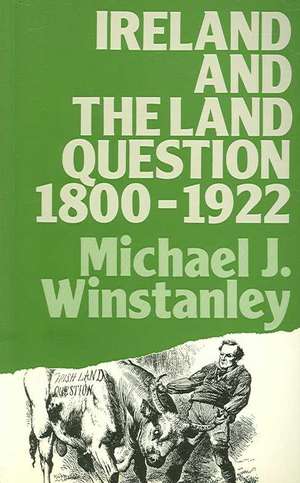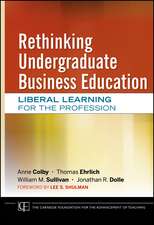Ireland and the Land Question 1800-1922: Lancaster Pamphlets
Autor Michael J. Winstanleyen Limba Engleză Paperback – 18 oct 1984
The land question has always been closely linked to the development of Irish national consciousness, and greatly exercised the minds of English politicians in the latter part of the nineteenth century. The author examines the nature of English understanding of Irish problems, which was often limited or ignorant, and attributes to it much of the unsound and ineffective ligislation passed. The book is concerned less with questions of English party politics than with the situation in Ireland itself and with the nature of the English response to it.
| Toate formatele și edițiile | Preț | Express |
|---|---|---|
| Paperback (1) | 358.35 lei 6-8 săpt. | |
| Taylor & Francis – 18 oct 1984 | 358.35 lei 6-8 săpt. | |
| Hardback (1) | 1000.27 lei 6-8 săpt. | |
| Taylor & Francis – 26 aug 2016 | 1000.27 lei 6-8 săpt. |
Din seria Lancaster Pamphlets
-
 Preț: 285.50 lei
Preț: 285.50 lei -
 Preț: 277.68 lei
Preț: 277.68 lei -
 Preț: 320.65 lei
Preț: 320.65 lei -
 Preț: 285.68 lei
Preț: 285.68 lei -
 Preț: 311.59 lei
Preț: 311.59 lei - 34%
 Preț: 764.20 lei
Preț: 764.20 lei -
 Preț: 344.69 lei
Preț: 344.69 lei - 18%
 Preț: 1000.27 lei
Preț: 1000.27 lei - 18%
 Preț: 1000.27 lei
Preț: 1000.27 lei -
 Preț: 343.17 lei
Preț: 343.17 lei -
 Preț: 205.26 lei
Preț: 205.26 lei - 18%
 Preț: 1000.27 lei
Preț: 1000.27 lei -
 Preț: 342.74 lei
Preț: 342.74 lei - 18%
 Preț: 234.80 lei
Preț: 234.80 lei - 18%
 Preț: 1000.27 lei
Preț: 1000.27 lei - 18%
 Preț: 1000.27 lei
Preț: 1000.27 lei - 26%
 Preț: 242.47 lei
Preț: 242.47 lei - 18%
 Preț: 1000.27 lei
Preț: 1000.27 lei - 18%
 Preț: 1000.27 lei
Preț: 1000.27 lei - 18%
 Preț: 1000.27 lei
Preț: 1000.27 lei - 18%
 Preț: 1000.27 lei
Preț: 1000.27 lei - 18%
 Preț: 1000.27 lei
Preț: 1000.27 lei -
 Preț: 339.50 lei
Preț: 339.50 lei - 34%
 Preț: 758.90 lei
Preț: 758.90 lei -
 Preț: 285.46 lei
Preț: 285.46 lei -
 Preț: 334.46 lei
Preț: 334.46 lei - 18%
 Preț: 1000.27 lei
Preț: 1000.27 lei - 27%
 Preț: 228.47 lei
Preț: 228.47 lei -
 Preț: 346.14 lei
Preț: 346.14 lei -
 Preț: 342.03 lei
Preț: 342.03 lei - 18%
 Preț: 992.38 lei
Preț: 992.38 lei - 18%
 Preț: 1000.27 lei
Preț: 1000.27 lei -
 Preț: 340.87 lei
Preț: 340.87 lei - 18%
 Preț: 1000.27 lei
Preț: 1000.27 lei - 18%
 Preț: 1000.27 lei
Preț: 1000.27 lei - 18%
 Preț: 1000.27 lei
Preț: 1000.27 lei - 15%
 Preț: 698.17 lei
Preț: 698.17 lei - 14%
 Preț: 764.20 lei
Preț: 764.20 lei - 27%
 Preț: 229.36 lei
Preț: 229.36 lei
Preț: 358.35 lei
Nou
Puncte Express: 538
Preț estimativ în valută:
68.58€ • 71.19$ • 57.18£
68.58€ • 71.19$ • 57.18£
Carte tipărită la comandă
Livrare economică 25 martie-08 aprilie
Preluare comenzi: 021 569.72.76
Specificații
ISBN-13: 9780416374209
ISBN-10: 0416374204
Pagini: 68
Dimensiuni: 138 x 216 x 5 mm
Greutate: 0.5 kg
Ediția:1
Editura: Taylor & Francis
Colecția Routledge
Seria Lancaster Pamphlets
Locul publicării:Oxford, United Kingdom
ISBN-10: 0416374204
Pagini: 68
Dimensiuni: 138 x 216 x 5 mm
Greutate: 0.5 kg
Ediția:1
Editura: Taylor & Francis
Colecția Routledge
Seria Lancaster Pamphlets
Locul publicării:Oxford, United Kingdom
Recenzii
`An excellent example of the genre - concisely, yet exhaustively, does what the series sets out to do ... ' - G.R. Elton, Cambridge University
`I would recommend this book.' - History Teaching Review
`I would recommend this book.' - History Teaching Review
Cuprins
Chapter Ireland and the Land Question 1800–1922;
Notă biografică
Michael Flood, Judith Kegan Gardiner, Bob Pease, Keith Pringle
Descriere
`I would recommend this book.' - History Teaching Review



